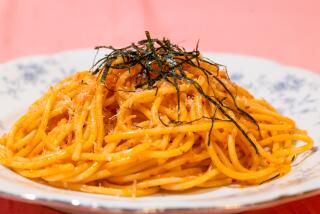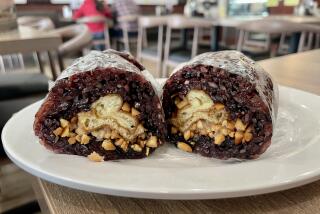A Gritty Tale of Shrimp for Breakfast
- Share via
Most people go to Charleston, S.C., for the architecture and the shopping. I went there for the food.
Specifically, I went to sample a comfort food known as shrimp and grits. For untold generations, this homey dish has been a traditional breakfast in the Low Country of South Carolina, enjoyed daily during shrimp season, which reaches its peak in November. At its simplest, shrimp and grits is just a plate of boiled hominy grits topped with shrimp simmered in a rudimentary gravy based on onions and bacon fat.
If you don’t come from the Carolinas, the idea of eating shrimp for breakfast may seem bizarre. But seafood isn’t unknown as a breakfast. Consider the British fondness for beginning the day with a plate of kippers or finnan haddie. Or bagels with lox or whitefish, for that matter.
The traditional way to cook grits is to simmer them in water. Unless you’ve grown up on boiled grits, you will probably find them bland, gluey and generally unworthy of epicurean hyperbole. That’s where Louis Osteen and the “little garlic syndrome” come in.
Osteen is the chef-owner of the celebrated Louis’s Charleston Grill at the Charleston Place Hotel. He’s also one of the greatest living practitioners of the art of preparing grits.
The “little garlic syndrome” is Osteen’s name for a theory put forth in the early days of the gastronomic revolution. It was that if a little garlic made a dish taste good, a lot would make it taste better. This quickly led to an onslaught of creations that were so garlicky you’d have to be living in vampire country to appreciate them.
The equivalent of the “little garlic” syndrome in the South was the “little milk” syndrome. Cook grits with a little milk, reasoned a new generation of Southern chefs, and they’ll taste better than if cooked in straight water. Soon, Osteen was using a lot of milk, then a little cream, then a lot of cream and butter. This proved to be the exception to the “little garlic” rule, for these enhancements greatly improved the grits.
It wasn’t long before Osteen was adding other embellishments. The gravy would be built on a rich blend of onions, peppers and celery sauteed in a little bacon fat. The traditional water would be replaced with shrimp stock. Finally, Osteen was making a shrimp and grits that could hold its head high among the more blue-blooded appetizers at his stylish restaurant--a shrimp and grits that transcended the breakfast category, that could rival the polenta of Italy or the paella of Spain.
In short, just the sort of shrimp and grits I went to Charleston to eat.
If you live in the South, you may be able to find fresh Charleston “creek” shrimp. Maine’s tiny pink shrimp would work well in New England. Wherever you live, choose the smallest, freshest shrimp (in the shells, please) that you can find. If you can find shrimp with the heads on, even better. For the best results, use slow-cook, stone- or water-ground, whole-grain grits. Quick-cooking grits will work in a pinch, but under no circumstances should you use instant grits.
SHRIMP AND GRITS
1 1/2 pounds shrimp with heads on or 1 pound headless shrimp
2 cups shrimp stock, fish stock, chicken stock or vegetable stock, or 1 cup bottled clam broth mixed with 1 cup water
3 tablespoons butter
1 1/2 cups water
1 1/2 cups milk
1 cup hominy grits
1/4 to 1/2 cup whipping cream or half and half
Salt
Freshly ground black pepper
2 tablespoons bacon fat or butter
1 onion, finely chopped
1 stalk celery, finely chopped
1/2 green bell pepper, finely chopped
3 tablespoons finely chopped parsley
2 tablespoons flour
Peel and devein shrimp, reserving heads and shells. Combine shrimp heads and/or shells and stock in saucepan and gently simmer 20 minutes.
Meanwhile, combine butter, water and milk in large heavy saucepan (preferably nonstick) and bring to boil. Add grits in thin stream, stirring constantly with wooden spoon. Bring grits to boil. Reduce heat and gently simmer, uncovered, until tender, 4 to 6 minutes for quick grits, about 20 minutes for stone-ground grits. Thin grits with cream as they thicken and add salt and pepper to taste. Grits should be consistency of soft ice cream. Remove pan from heat and set aside.
Heat bacon fat in large skillet. Add onion, celery, bell pepper and 1 1/2 tablespoons of parsley and cook over medium heat until soft and translucent but not brown, about 5 minutes. Stir in flour and cook until just beginning to brown, about 2 minutes. Remove from heat.
Strain simmering shrimp broth and add to pan. Bring mixture to boil, stirring constantly. Add shrimp and remaining 1 1/2 tablespoons parsley and simmer until shrimp are cooked, about 2 minutes. Correct seasoning, adding salt and pepper to taste. (If gravy seems too thick, add little more shrimp stock.)
To serve, spoon grits into shallow bowls or soup dishes. Spoon shrimp and gravy over top.
Makes 4 to 6 servings.
Each of 6 servings contains about:
376 calories; 587 mg sodium; 188 mg cholesterol; 17 grams fat; 29 grams carbohydrates; 26 grams protein; 0.32 gram fiber.
More to Read
Sign up for The Wild
We’ll help you find the best places to hike, bike and run, as well as the perfect silent spots for meditation and yoga.
You may occasionally receive promotional content from the Los Angeles Times.






